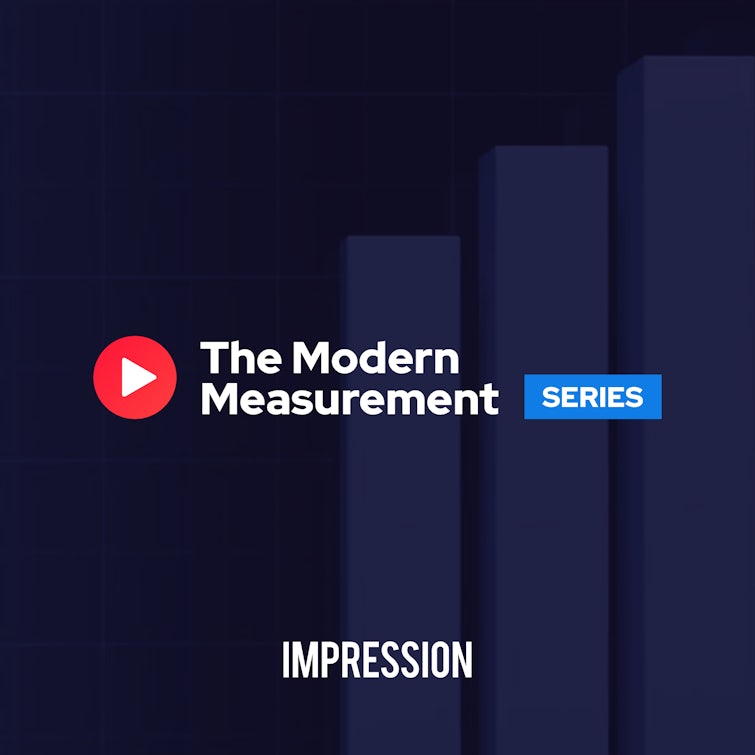There’s a huge buzz around media measurement and marketing effectiveness in the industry right now, and for good reason. The phase-out of the third-party cookie presents advertisers with attribution challenges that not only make it more difficult to make strategic decisions but also to achieve stakeholder buy-in for marketing investment.
To help you improve your knowledge of the modern measurement landscape and understand the best solutions to embrace user privacy without hindering marketing performance, Impression has launched a series of short videos.
Watch the full series here and gain insights into:
- The current technology and privacy headwinds challenging digital attribution
- How to respect user privacy online and implement compliant solutions
- How to more accurately measure the impact of your efforts through different solutions e.g. multi-touch attribution, incrementality testing and media mix modelling
- How to communicate the value of marketing measurement to key stakeholders
In part two, Technology Director, Aaron Dicks and Head of Media Solutions, Harry Brace explore:
- Recent changes in privacy laws and the impact on the data landscape
- Consent management and tools to maintain quality data gathering
- The benefits of moving to server-side tracking
- How accessing better data can drive greater high-value conversions
See the transcript of the video below the recording.
Aaron Dicks: There are a lot of changes coming our way at the moment as marketers, that are impacting both of our roles, across marketing technology, attribution and data science. Maybe we can dive through a few of those right now. Let’s kick it off and look at the marketing technology side of things. What’s happening there?
Harry Brace: As privacy laws have developed over the years, we’re constantly trying to find ways to maintain the quality of data that we have, whilst also maintaining privacy considerations of the users and maintaining what their preferences are. One of the bigger changes that have happened in recent times is the Digital Markets Act. They released a list of what they consider their gatekeeper organisations, which to no one’s surprise, are the big companies. They’ve been releasing solutions to try and be compliant with this new legislation, like different bits of tech that will help improve the data quality, whilst maintaining privacy. One of the key ones that a lot of people may have heard of is Consent Mode.
Aaron Dicks: So with regards to these changes then, what is it that a business or brand right now, can do to stay on the right side of handling that data compliantly?
Harry Brace: One of the probably most obvious things to do is to use a Consent Management Platform or CMP as they’re known. Most people would have seen these as they’re browsing the web, it’s those pop-ups that appear and ask do you consent to cookies? What cookies do you consent to? One thing that I think is key to check as a business is whether or not what you have in place is actually functional. You’d be surprised by the amount of Consent Management Platforms that are implemented but not actually doing what they should do in the background. Check with your developers, and make sure that what’s in place is actually functioning and it’s actually listening to what users consent to.
Aaron Dicks: So looking at the Consent Management Platform is a great way, I guess, of tackling that sort of head-on headwind around dealing with consent and marketing consent in this case for that data. That’s going to have an impact on data quality and I know there are a few different pieces of technology we can use to enhance that information and make sure we’re still providing some information to the ad platforms and go one step further and make sure we’re plugging those gaps as well. Maybe you can talk around a few of those options?
Harry Brace: By not having various different JavaScript libraries and just collecting the data that they see fit, you can control exactly what data is collected on your site to your server-side container, and you can redact any information that you consider private and that shouldn’t be sent to the platforms. Obviously, this is fundamentally controlled by whether or not the user had consented to tracking in the first place, and if that’s the case, then obviously the rest of this can happen.
One of the biggest ways to improve data quality is to start moving towards more of a server-side tracking environment. It has a ton of benefits, first of all, you have much more control over your data instead of having various JavaScript libraries, client-side, just collecting what data they see fit, you control exactly what is sent to the platforms, and then pass on to the actual advertising platforms. One of the other key benefits is that because you’re removing all of that JavaScript bloat, you’re inherently making your site faster, you’re removing a lot of the unneeded code, essentially. These server-side containers tend to point to, or at least we recommend pointing them to a first-party domain, which means that your cookies that are getting set are in a first-party context, which means they’ll last longer and give you better data when it comes to tracking things like conversions.
Another benefit of having server-side tracking setup is that you can connect to other platforms. Another platform might be your CRM, especially if you’re a lead-gen business, you might have a longer conversion funnel when a lead becomes a customer. You can send conversion data that’s not just from an initial lead, you can send qualified leads or any sort of step within your funnel that you think would benefit from being tracked. You can send that through to your server-side container and then pass that on to the marketing platforms. Then again in turn, you can optimise towards those high leads, so you can really start to close that conversion loop and start optimising to better quality leads, essentially.






